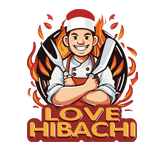
Walk into a Japanese steakhouse in the US, and you'll likely hear the term "hibachi." You picture the large, flat iron grill, the entertaining chef flipping shrimp tails into their pocket, the volcano onion stack erupting in flames. It's a fun, delicious, and interactive dining experience. But is that really hibachi?
If you delve into Japanese culinary terms, you'll find that what most Americans call "hibachi" dining is actually "Teppanyaki."This common mix-up often leaves food lovers curious: what is the actual difference, and does it even matter? Let's slice into the history and characteristics of both to clear up the confusion.
The word "hibachi" (火鉢) literally translates to "fire bowl." Dating back possibly as far as the Heian period (794-1185 AD) in Japan, traditional hibachi were originally heating devices. They consist of an open-topped container, often round and made of ceramic or wood lined with metal, designed to hold burning charcoal.
-The Cooking Surface: For cooking, a grate is placed over the top of the fire bowl. This makes a traditional hibachi grill function much like a small, portable barbecue grill.
-Heat Source: Traditionally, charcoal (especially high-quality binchotan) is the fuel, imparting a distinct smoky flavor.Modern versions, especially those adapted for indoor restaurant use or home convenience, might use electricity.
-Cooking Style: Because of the open grate design, traditional hibachi grilling is best suited for grilling larger pieces of meat or vegetables directly over the coals. It's generally a more straightforward grilling method, focusing on the smoky flavor imparted by the charcoal. It's less about intricate knife work or cooking loose ingredients like rice directly on the surface.
-Atmosphere: Historically used for heating or simple, often intimate grilling, the traditional hibachi experience is typically more subdued than the restaurant spectacle many associate with the name.
"Teppanyaki" (鉄板焼き) combines the words "teppan" (iron plate) and "yaki" (grilled, broiled, or pan-fried). This style of cooking is a more modern invention, gaining popularity in Japan after World War II and introduced to the US, arguably becoming even more famous there.
The Cooking Surface: The defining feature of Teppanyaki is the large, flat, solid iron griddle. This provides a smooth, continuous surface for cooking.
Heat Source: Teppanyaki grills typically use propane or electricity, allowing for consistent and controllable heat across the large surface. This makes them suitable and safer for the indoor, tableside cooking performances they are known for.
Cooking Style: The solid flat-top is incredibly versatile. Chefs can sear meats, sauté vegetables, cook eggs, and even prepare fried rice directly on the griddle. It lends itself perfectly to the theatrical chopping, flipping, and tossing displays that make Teppanyaki dining so entertaining. The focus is often on precise cooking, combined with sauces and seasonings applied during the cooking process.
Atmosphere: Teppanyaki is synonymous with the lively, interactive dining experience.Guests are seated around the grill, watching skilled chefs perform culinary feats, making the meal preparation itself a form of entertainment.
So, why do most Japanese steakhouses in America call their Teppanyaki grills "hibachi"? It's largely a matter of marketing and history. When this style of restaurant became popular in the US (Benihana being a key pioneer in the 1960s), the term "hibachi" was likely chosen because it sounded more familiar or exotic to American diners, even though the cooking style was Teppanyaki. Over time, "hibachi" became the commonly accepted term in the US for this theatrical, flat-top grilling experience.
Understanding the difference doesn't change how delicious the food is! If you love that Japanese steakhouse flavor, you have options:
Backyard Grilling: You can find portable grills marketed as a hibachi grill.[2][3][5][6] Some might be closer to the traditional charcoal grate style (great for a smoky flavor on skewers or small items), while others might be small, flat-top propane grills trying to replicate the Teppanyaki experience.[6] Cast iron versions are often recommended for durability and heat retention.[5]
Hibachi Delivery: Craving the taste without the cooking? Many restaurants now offer hibachi delivery. While you miss the tableside show, you can still enjoy expertly cooked steak, chicken, shrimp, fried rice, and those famous sauces delivered right to your door through services like Uber Eats, Grubhub, or DoorDash. Search for "hibachi delivery near me" to find local options.
The Ultimate Experience: To truly capture the magic – the dazzling performance and the delicious food – consider bringing the restaurant experience to your home or event.
For an authentic and entertaining meal that combines skilled cooking with fresh ingredients and those irresistible sauces, booking a private chef service can make any occasion special. If you want the excitement and flavors of the Japanese steakhouse brought directly to you, check out







